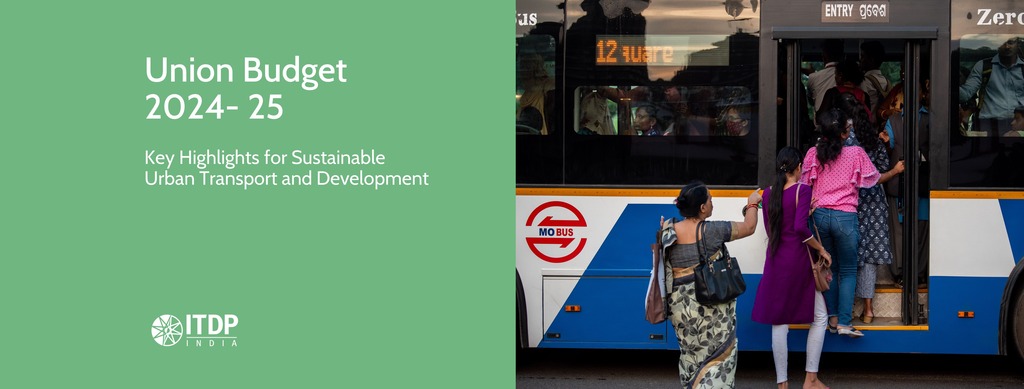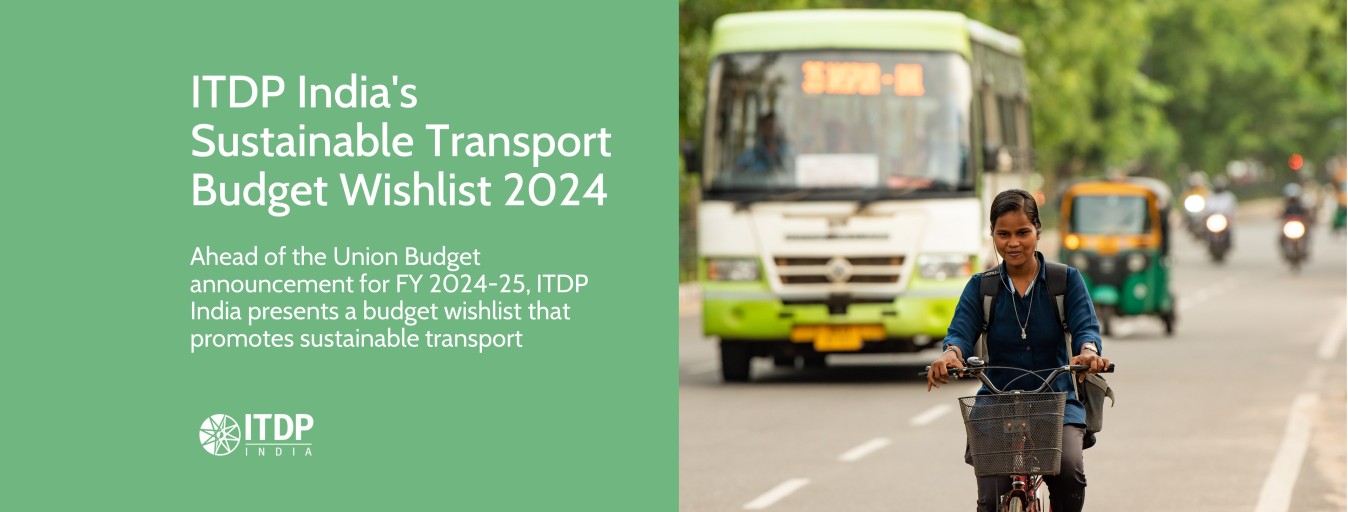Estimated time to read- 6 minutes
The Union Budget for the financial year 2024-25 was released on July 23. Here are some of the key highlights on sustainable urban transport and development and what we feel about these proposals.
1. Continued support for National Clean Air Program
The National Clean Air Program continues to receive robust support, with INR 858.5 crores allocated for 131 cities. As part of this initiative, 100 cities are preparing detailed City Action Plans, and these same cities are actively implementing air quality improvement measures in accordance with their plans, supported by the allocated funds.
What we feel
We appreciate the continued commitment for implementation of the National Clean Air Program. The key component in the implementation roadmap for NCAP must include policy, technical, and budgetary support to states and cities. The support should be towards adopting parking policies, implementing parking management measures, and setting up low emission zones that focus on restricting polluting vehicles.
2. Taxonomy for Climate Finance
This budget spoke about the development of a taxonomy for climate finance for enhancing the availability of capital for climate adaptation and mitigation. This will support achievement of the country’s climate commitments and green transition.
What we feel
It is heartening to see the intent to create a Taxonomy for Climate Finance. The taxonomy must identify all sectors of sustainable mobility including walking and cycling which is usually overshadowed by the glamours of e-mobility. The taxonomy must also align with allocated budgets to support implementation and policies to ensure the longevity of the intervention.
It is also important to adopt a result-oriented approach for both NCAP and taxonomy so that tracking and reporting mechanisms can ensure that funds allocated for sustainable mobility are used effectively. This helps in identifying gaps and making necessary adjustments to improve project outcomes.
3. PM EBus Sewa Scheme: Boosting Electric Buses
The budget set aside INR1,300 crores specifically for the PM e-Bus Sewa scheme to introduce 1,000 e-buses in FY 2024-25 across various cities, taking it to a total of 1,500 e-buses under the scheme since its inception.
What we feel
It is heartening to see the increased commitment to electric buses and sustainable urban transport from last year’s allocation of only ₹20 crores. However, considering the acute shortage of urban buses in India, there is a need for a 15-fold scale-up of national programs like the PM-eBus Sewa scheme to ensure More Buses, Better Buses, and Green Buses in all cities.
4. Promotion of Electric Mobility
The Lithium has been fully exempted from customs duties as compared to the 2.5% – 10% custom duty rate in the previous financial year.
What we feel
Exempting custom duties on critical minerals like lithium and cobalt is a welcome step as it will lower the production costs of battery cells. This cost reduction directly translates into more affordable electric vehicles for consumers, supporting the goal of widespread EV adoption in India.
5. FAME Scheme: A Mixed Bag
The Faster Adoption and Manufacturing of Electric Vehicles (FAME) program has been a key driver for EV adoption. The program received INR 2,600 crores to promote the adoption of electric vehicles and enhance the manufacturing ecosystem for EVs in India. However, the scheme is ending in 2024.
What we feel
It is essential to note that while FAME received funding of INR 2,600 crores it is only to cover the remaining liabilities of Fame II. The funding allocation is for the conclusion of the scheme in 2024 with no announcement of FAME III in the budget. This shows the shift in the national government’s approach to subsidise overall electric mobility going forward and keep the focus on prioritized sectors like public transport.
6. Transit Oriented Development
Transit Oriented Development (TOD) was spotlighted in the budget. It mentioned that TOD plans for 14 large cities with a population above 30 lakhs were to be formulated, along with an implementation and financing strategy.
What we feel
We also welcome the TOD plans as these will create compact, walkable communities centered around high-quality public transport systems. It will maximise accessibility and convenience of public transportation, reduce reliance on private vehicles, and promote sustainable urban growth. To ensure the TOD plans are developed and implemented in coordination with all city agencies, it will be important to empower these cities with an operational Unified Metropolitan Transport Authority (UMTA) or a Green Mobility Cell. These entities should be empowered legally and financially to facilitate coordination, planning, and execution of sustainable transport initiatives among various agencies.
7. Creative redevelopment of cities & Cities as Growth Hubs
Towards the creative brownfield redevelopment of existing cities with a transformative impact, the budget stated that the government will formulate a framework for enabling policies, market-based mechanisms, and regulation.
The budget also highlighted working with states to facilitate development of ‘Cities as Growth Hubs’. This will be achieved through economic and transit planning, and orderly development of peri-urban areas utilising town planning schemes.
What we feel
The commitment to creative brownfield redevelopment and the development of ‘Cities as Growth Hubs’ is a commendable step towards sustainable urban transformation. The proposed framework for enabling policies, market-based mechanisms, and regulations will provide a solid foundation for revitalising existing urban areas, fostering economic growth, and improving living conditions.
ITDP India’s Sustainable Transport Wishlist
The budget also captured the following-
- Street Markets : Building on the success of PM SVANidhi Scheme in transforming the lives of street vendors, our Government envisions a scheme to support each year, over the next five years, the development of 100 weekly ‘haats’ or street food hubs in select cities.
- Infrastructure investment by state governments : Encourage states to provide support of a similar scale for infrastructure, subject to their development priorities. A provision of INR 1.5 lakh crores for long-term interest-free loans has been made this year also to support the states in their resource allocation.
- Continued support for Smart cities : The budget has shown a continued commitment towards Smart Cities Mission by allocating a capital outlay of INR 2237 crores.
The Union Budget 2024 is demonstrating a clear commitment to decarbonization through initiatives like the climate taxonomy and Transit-Oriented Development (TOD) measures, as well as continued support for the PM-eBus Sewa scheme.
While acknowledging these positive strides, we recommend that further attention be devoted to laying the foundational groundwork for pedestrian-friendly, cycling-friendly, and public transport-oriented cities. We hope the government will build upon the announced sustainable policies by implementing Low Emission Zones (LEZs), parking policies, and granting greater autonomy to Urban Metropolitan Transport Authorities (UMTAs). Higher support to electrification of public transport fleets is also a need of the hour.
By refining these finer details, we can collectively work towards a more comprehensive and effective sustainable transport framework.
Written by ,
Vaishali Singh, Programme Manager, E-mobility and Public Transport Systems and
AV Venugopal, Programme Manager, Healthy Streets and Partnerships
Edited by Donita Jose, Senior Associate Communications and Development






